
Companies like Netflix and Amazon have set a high bar for retailers when it comes to personalizing online shopping experiences. In fact, more than half of consumers say they expect that companies will anticipate their needs and make recommendations before they even make contact. While this may sound daunting, it doesn’t have to be.
We reached out to our friends at Nosto – a leading eCommerce personalization platform – to get their perspective, tips and best practices on how to apply a personalization strategy to an eCommerce website. You can create not only more productive and enjoyable shopping experiences for your customers – at scale – but also boost conversion rates and revenue for your brand.
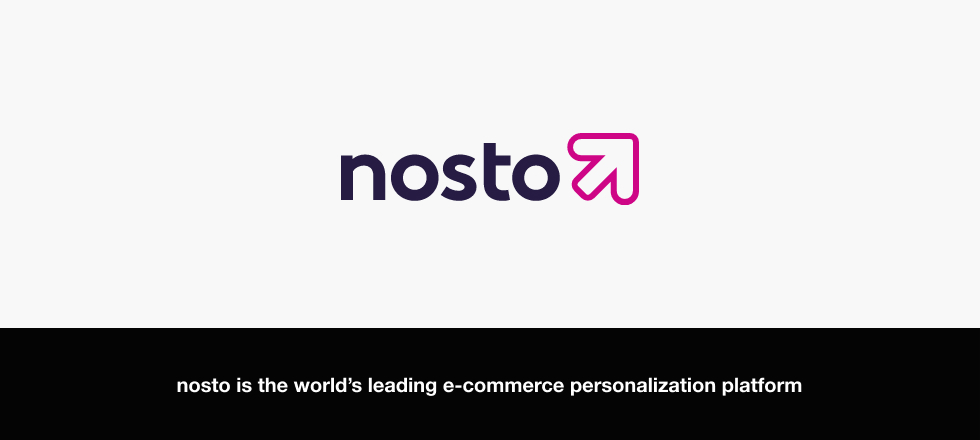
Personalization – or the ability to tailor the customer journey and overall customer experience based on behavioral data used to understand a customer’s specific preferences, interests and intentions – has become a fundamental asset for eCommerce sites. The more hyper-personalized companies can make customer experiences, the greater increases they see in customer loyalty and revenue. According to a Forbes Insights survey, 40% of executives said that personalization directly impacted their company’s sales, cart value and profit.
Nosto’s Partnership Manager adds, “In our experience, when our clients apply a personalization strategy using our personalization platform, they see an average 10-30% increase in revenue and a 7x return on investment.”
Getting started: eCommerce personalization essentials
Personalization tools enable merchants to take their eCommerce sites to the next level. A personalization platform collects historical and real-time behavioral data from eCommerce sites, as well as integrates with backend systems, email platforms, ERP systems, social media platforms and more to unify personalization across channels.
How does the customer experience personalization? Personalization can be in the form of page content, product recommendations, promotions, advertising, email content and more. However, you can’t do it all at once when you first get started (or at least most companies can’t!). Following are three key areas where Nosto recommends eCommerce merchants focus their personalization efforts to achieve the highest return on their investment.
1. Product recommendations
If you’re not offering personalized product recommendations on your site, you could be missing out on as much as 10-30% incremental revenue on average! In addition to tried-and-true approaches like “If you like X, try Y,” there are many other recommendation tactics that are worth exploring to help customers discover new and complementary products. In fact, there are nearly limitless variations based on what data you have available and how/where you present the recommendations on your site. For example, there are multiple ways to approach featuring “best sellers,” and here are just a few:
- Highlight geo-targeted best sellers on the homepage for new users
- Feature best-selling complementary products on a product page
- Upsell a best-selling, costlier model of a product on a product page
- Offer “add-on” best sellers on the cart page to lift average order value (AOV)
Overall, Nosto has found that offering personalized best sellers – by recency, popularity, or geography – can drive a 50% on-page click-through rate. Below is an example of how a brand highlighted customer favorites, specifically for its New York customers.
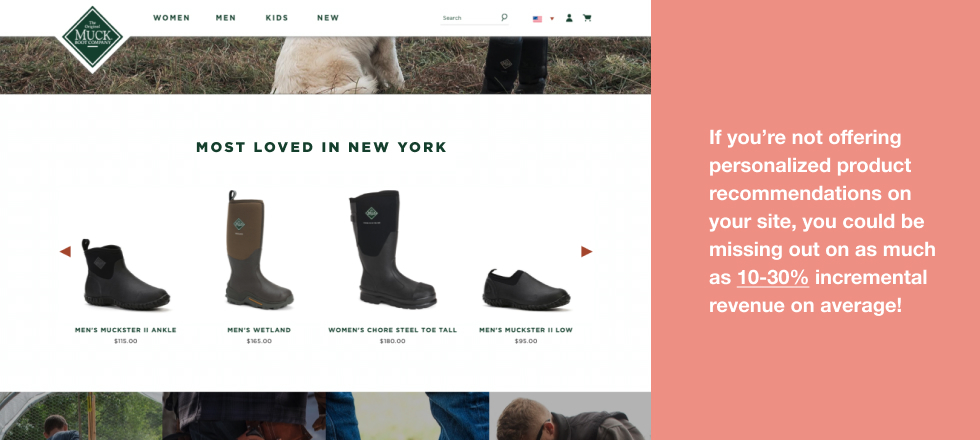
In addition, there is a multitude of different algorithms you can use to slice and dice data to deliver the most compelling and tailored product recommendations. For example, if the data shows a customer likes white t-shirts, but they haven’t shown a propensity to convert for on-sale products, you could serve them recommendations for white tees that have a higher margin. Or, if the customer likes a certain pattern or silhouette, show them other similar products, as you can see from the example below.
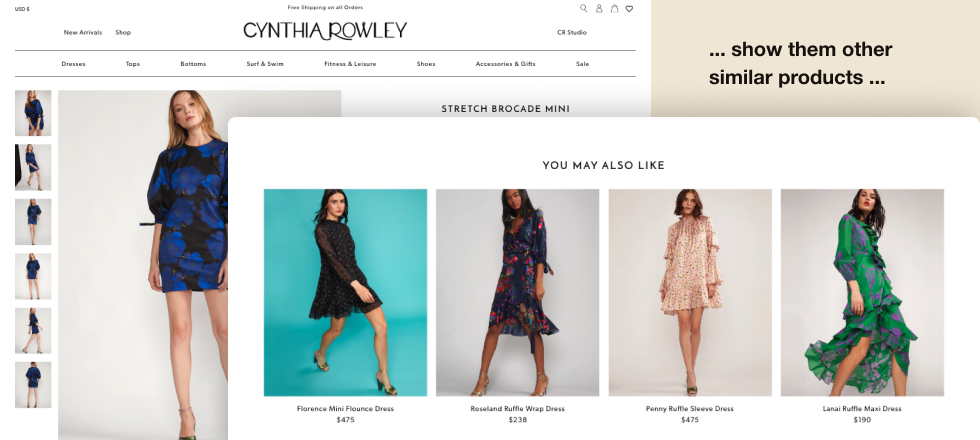
2. Email personalization
You can’t add someone’s name to an email and call it personalization any longer. Instead, it’s all about the widgets. These are little snippets of code that when inserted into email templates, allow you to automatically serve up dynamic content that’s most relevant to the recipient, based on customer data to improve the customer journey. It’s effective for nearly any scenario, including retargeting (e.g. enticing consumers to convert), transactional emails (e.g., cart abandonment or purchase confirmation), newsletters (e.g., articles pertinent to a consumer’s most recent behavior on the site), and more.
Significantly for your bottom line, personalizing emails with relevant content and products can transform non-revenue-generating emails into moneymakers. For example, if a customer recently purchased a camera, the “thanks for your purchase/here’s your receipt” email (which has a very high open rate) could be personalized to include recommendations for complementary products they may not have considered but need, such as lenses, carrying bag, etc. – extremely useful information sent at just the right time.
Here’s a great example of a cart abandonment email:
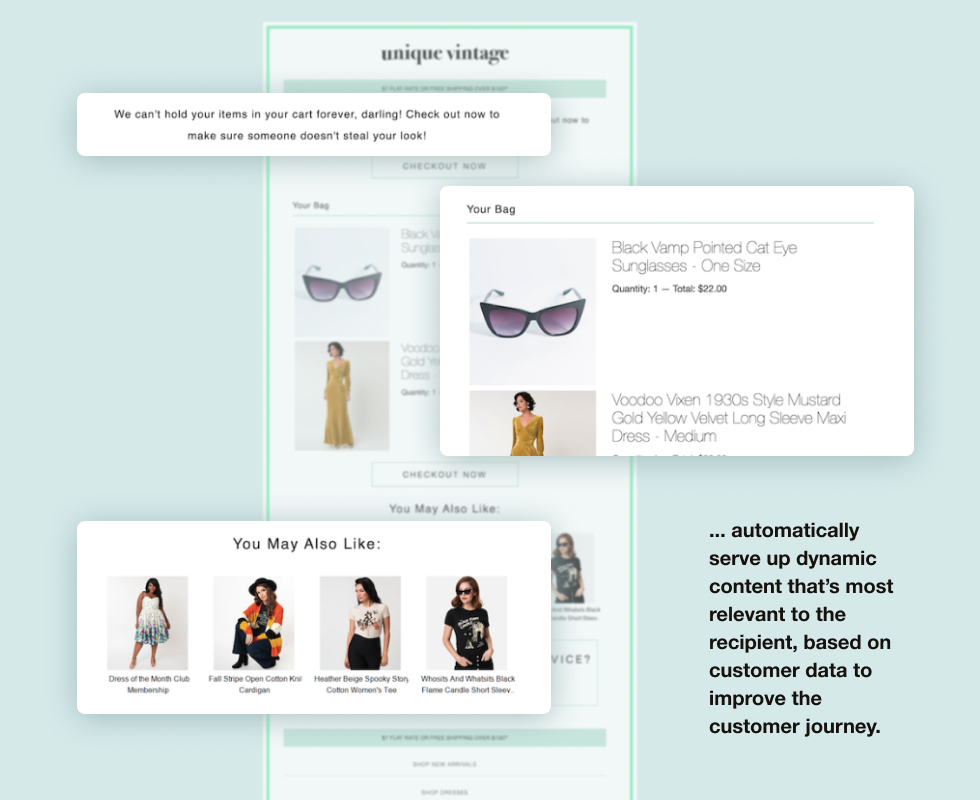
3. Full site content personalization
Enabling a personalized experience throughout an entire site can be a game-changer for brands, making the eCommerce experience so customized and intuitive that it’s a no-brainer for customers to convert. Depending on the customer, they could see different navigation choices, content, banners, product recommendations and more. You can deliver totally different experiences to different customers, all on the same site.
The ToolStop site is a great example of this. You can see below how the site looks for a loyal purchaser of Makita brand products versus just your average shopper.
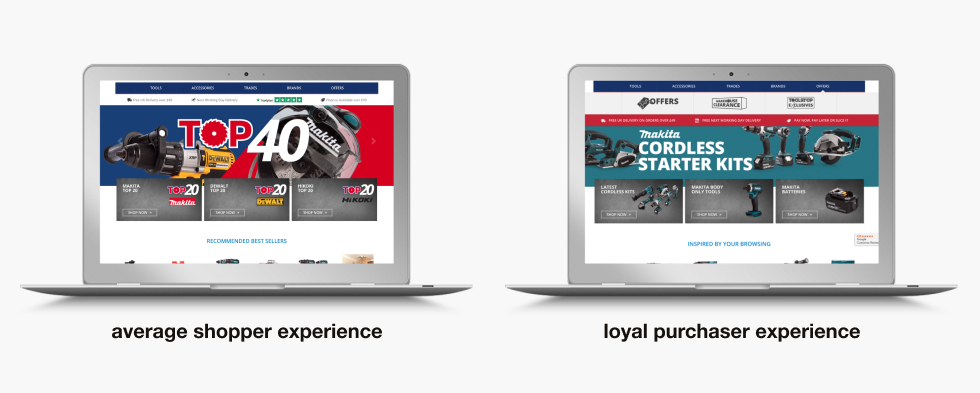
Best practices for effective personalization
When you’re ready to implement or improve personalization on your eCommerce site, the following are some best practices to consider to support your success.
- Be holistic: To get the most out of your personalization efforts, personalization should be thought of an extension of your eCommerce marketing strategy. You can’t just swap out a banner on the home page and expect results. Instead, consider personalizing touchpoints throughout the entire customer journey from product discovery to checkout, including social media, user-generated content, emails, page content, advertising, and more.
- Don’t bite off more than you can chew: The maturity of your business and your marketing and business goals will determine what personalization efforts are a “must” and which can be phased in later. For companies just starting to explore personalization, it makes sense to take a “crawl, walk, run” approach to ensure success. Working with eCommerce personalization experts can get you off the ground faster, helping you optimize your site to see results faster.
- Use the right platform: You don’t want to spend a lot of time and effort implementing, integrating and maintaining your personalization technology. Ensure the platform you choose offers automation to save your team time (doesn’t require a dedicated person), can quickly deliver results and easily integrates with your other systems. Also make sure the platform complies with data privacy regulations, including GDPR.
- Let the technology do its job: Personalization technology uses machine-learning to continuously make itself smarter. Don’t always try to second-guess it! Yes, there are filters you can use to customize what products should be recommended – but if you put too many filters on, you won’t be getting the full benefit from the technology. Nosto says they often hear from merchants that they’ve received surprising and helpful insights about customer preferences and buying patterns that were revealed by the personalization platform.
A look ahead
Where does Nosto see personalization heading in the future? Personalization is starting to go omnichannel; that is, brands are looking at new, smart ways to use data gathered from multiple channels like web, mobile and POS systems to create more relevant, personalized shopping experiences across all touchpoints. For example, in physical stores, shoppers are presented with a lot of products that they’re not interested in. Can a brick-and-mortar in-store experience be tailored so that it feels like an extension of a personalized website or app experience? Can we better serve customers in physical locations if we already know their preferences? More and more retailers think so. In fact, global spending on AI for retail is projected to hit $7.3 billion per year by 2022, up from $2 billion in 2018.
Technology also is helping to make communication and data sharing between channels seamless. Some retailers are testing smart screens in their brick-and-mortar stores that can serve up personalized recommendations and offers for each customer based on online behavior. Retailers also are leveraging POS systems and app data to prompt in-store merchants to offer personalized information and best-selling complementary products at checkout. And, after an abandoned app browsing session, technology enables a brand’s app to know if a customer purchased the product in a physical store, so that the app ceases to remind the customer to revisit the cart.
Personalization or bust
Personalization is essential to stay competitive in eCommerce today. One study reported that 94% of businesses agreed that personalization was critical to their current and future success. With the right technology platform and a solid marketing strategy, you can do effective personalization at scale and across channels.
Thanks to the team at Nosto for contributing their expertise to this post!
Contact eHouse Studio today to learn how to harness the power of the Shopify Plus platform to take your top brand to the next level of success.